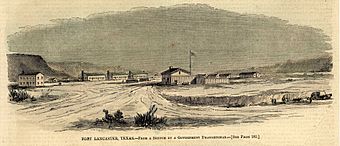Fort Lancaster facts for kids
|
Fort Lancaster
|
|

Sketch of Fort Lancaster from 1861
|
|
| Location | Crockett County, Texas, USA |
|---|---|
| Nearest city | Sheffield, Texas |
| Area | 39 acres (16 ha) |
| Built | 1855 |
| NRHP reference No. | 71000928 |
Quick facts for kids Significant dates |
|
| Added to NRHP | March 11, 1971 |
Fort Lancaster was one of many forts built in western Texas. It is located in the Pecos River Valley, near Live Oak Creek, in Crockett County, Texas, United States.
Captain Stephen Decatur Carpenter started the fort on August 20, 1855. Its main job was to protect military supplies, trade goods, and people traveling along the important San Antonio–El Paso Road. Today, the 82-acre site is called Fort Lancaster State Historic Site. It is managed by the Texas Historical Commission. Visitors can see the remains of twenty-nine buildings that once formed the fort. There is also a visitor center with a museum that shares the fort's interesting history.
Contents
The Story of Fort Lancaster
Building the Fort
On August 7, 1855, Captain Stephen Carpenter left Fort Duncan with his soldiers. They arrived at Live Oak Creek on August 20 and set up Camp Lancaster. The camp was likely named after Job Roberts Hamilton Lancaster, a friend of Captain Carpenter.
At first, the soldiers lived in tents. Soon after, they built simple shelters called jacales covered with canvas. Later, special pre-made buildings, called "Turnley Portable Cottages," were brought by wagon from San Antonio. These parts were then put together at the site.
Early Challenges
On October 12, 1855, Captain Carpenter and a small group went looking for a tree to use as a flagpole. They met a group of Apache people. In a short fight, one teamster (a person who drives a team of animals) was killed. Captain Carpenter was shot in the hand, but his pistol stopped the arrow from going deeper. He shot one warrior, and another soldier shot a second warrior. The group returned to the fort after this dangerous encounter.
Growing the Fort
Captain Robert S. Granger took command on February 2, 1856. Camp Lancaster officially became Fort Lancaster on August 12, 1856. By 1857, stone and adobe buildings were being built for the soldiers. On July 9, the United States Camel Corps even stopped at the fort on their way to New Mexico. By 1858, 152 soldiers were stationed at Fort Lancaster.
Abandonment and Return
The U.S. Army left Fort Lancaster on March 19, 1861. This happened after Texas decided to leave the United States at the start of the American Civil War. U.S. soldiers and their families were allowed to leave with their belongings.
From December 1861 to April 1862, soldiers from the Confederate States Army occupied the fort. After the Civil War ended, Texas troops also left. The fort's buildings then started to fall apart due to weather and people taking materials.
When the Civil War ended, the U.S. Army returned to Texas. Other forts were built, and the 9th Cavalry (a unit of African American soldiers with white officers) was stationed at Fort Lancaster. These soldiers protected stagecoaches and fought against Apaches.
On December 26, 1867, a large group of Kickapoo and Comanchero raiders attacked the fort to steal horses. The soldiers fought them off but lost 38 horses and mules. The raiders tried again two days later but failed. After this, the fort was not attacked again.
In 1871, the fort's troops helped deal with a Kiowa-Comanche uprising. After this conflict ended, the fort was completely abandoned around 1873 or 1874. Over the next few decades, many of the fort's building materials were used for other buildings, especially in nearby Sheffield.
Discovering the Past
Archeological Finds
Within 40 years of being built, some of the fort's wooden buildings burned down. By 1912, only a few walls, a chimney, and many foundations remained. This is how the site looked when the first scientific archeological studies began in 1966.
More studies were done in 1971. Archeologists mapped the site and dug test holes. In 1974, they found that officers' quarters had wood floors and doorframes. These burned wood pieces were left in place, photographed, and carefully recorded. The dig sites were then refilled with soil to protect the remains for future viewing.
Later digs in 1975 and 1976 showed that the commanding officer's home and the store also had wooden parts that were destroyed by fire. These studies helped archeologists understand how the fort's buildings were designed and built.
Protecting Fort Lancaster
Preservation Efforts
In 1968, private owners gave Fort Lancaster to Crockett County to protect it and allow public access. The land was then given to the Texas Parks and Wildlife Department (TPWD) on April 16, 1968.
TPWD tried to restore parts of the fort. They used modern cement to strengthen the remaining stone walls. They also used cement-fortified adobe to rebuild parts of the enlisted men's mess hall.
In 1976, archeologists made new adobe bricks from mud found at the site. These new bricks were the same size as the original ones. They were placed on top of the old adobe walls of some officers' quarters. This helped protect the original walls.
Due to money issues, the State transferred management of the site to Texas Rural Communities, Incorporated, in 1993. Then, on January 1, 2008, the Texas Historical Commission took over. They now manage the preservation and public visits to Fort Lancaster.
You can see a small model of Fort Lancaster at the Crockett County Museum in Ozona, Texas.
Images for kids






